|
From September 2007
to summer 2010, I taught English at Kunming Medical University. In the fall, I taught
first-year grad students ("post-graduate students" in British English); in
the spring, I continued teaching about half of my fall students, plus
another 70 or so undergraduates. The old campus was near our apartment in
Kunming, so we did many things with students both on campus and at home
for the first two years.
Unfortunately, in the third year (2009) my classes moved to a new campus in Cheng
Gong. I rode a chartered bus between the old and new campuses; on a good
day it took an hour; the longest ride was about three hours (the traffic
in Kunming was terrible, with one of the highest per capita numbers of
private cars in China's big cities). This long drive was one factor in our
decision to return to China's east coast after 8 years of service in the
west. (Our next location was Xiamen.) |
|

This composite
shot shows the new front gate, flanked by administrative offices. You can
see mountains on the far left. This is really four photos, which
illustrates how huge the campus is!
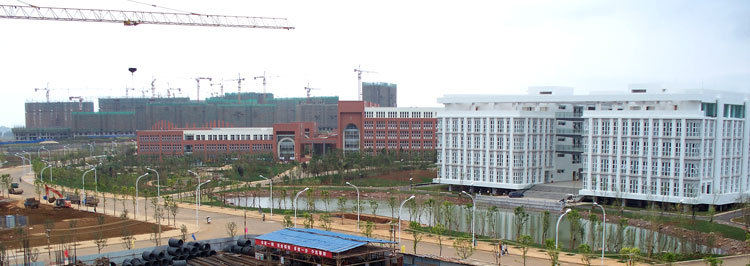
|
|
My office was in the shortest building here (third/top floor of the
Foreign Languages Department). The white building is the library. Many of
the teachers have "purchased" apartments (condos) in the complex that is
rising behind the campus (hopefully to be done in 2010). ["Purchased" is
not exactly accurate; China's government owns all the land, but "rents" it
to developers, who "sell" housing units on the leased land for 50-90
years. Even the university is also on leased land.] Grad dorms are out of
the photo on the left; undergrad dorms (like the one I'm standing in) are
out of the photo to the right, as are most of the the classroom buildings.
I think the building rising in the foreground is an auditorium or sports
facility. While a number of buildings have elevators, many don't (like my
office building, and the six-floor dorm I slept in on Monday nights;
teachers can book a free room on the sixth floor for one night). Unlike
buildings and campuses in America, Chinese developers do not have to make
things accessible to handicapped people. Just dragging a suitcase around
this campus can be a challenge, so I feel for those who use a wheelchair.
In truth, I rarely see wheelchairs in China, though I occasionally see
students temporarily on crutches trying to hobble up the stairs. |
The
following essay talks about some of the positive changes. It was written
by Megan, one of my 2009 grad students.
In the past seven
years, new multi-media devices and modern lab equipment have helped
Kunming Medical University's teachers meet students' needs. Each classroom
has been equipped with multi-media devices and more teachers have started
to skillfully use them. Compared with the traditional teaching methods
such as using chalk and blackboards, pictures, vivid flashes and videos
add depth and interest to the knowledge being presented. Multi-media
devices have also offered an easier and more convenient way for students
to master difficult medical knowledge. In addition, lab equipment has been
replaced or added. Especially in some critical laboratories (such as Cell
Biology, Anatomy and Phamacology), students now enjoy the best learning
resources and experimental conditions in Yunnan Province. New multi-media
facilities and updated lab apparatus have both improved students'
professional skills and helped them become better prepared for
the competitive job market. |
|
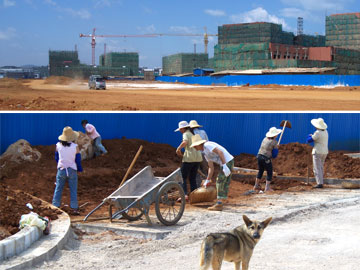
This is what the new campus looked like on
my first visit, May 2008. I've seen several small children like this at
construction sites, near their working mothers. (Click
here for another example.) |
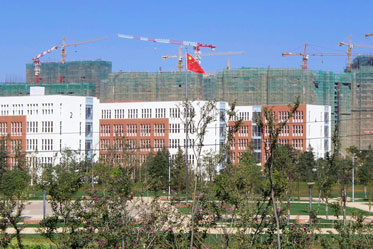
I saw this view
from one of my classrooms. All over China you can see the nation's red
flag with yellow stars, flying proudly in front of construction sites and
building cranes. |
|
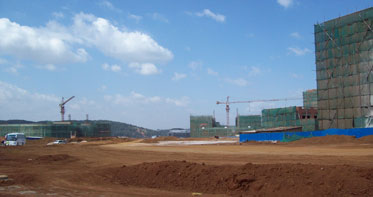
This photo is
also from May 2008. |
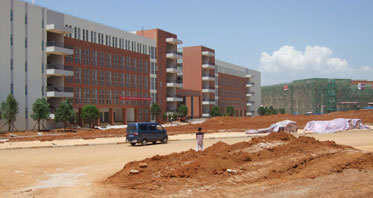
Our next visit
was May 2009; most of the buildings looked "done," but they had just
started bringing in the trees and other greenery. |
|
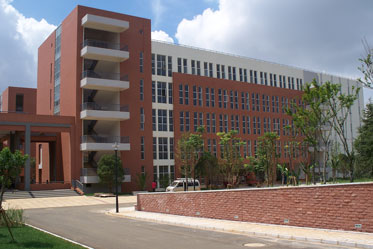
The campus
opened in August 2009. This building (same as above right) is where my
grad classes met. |
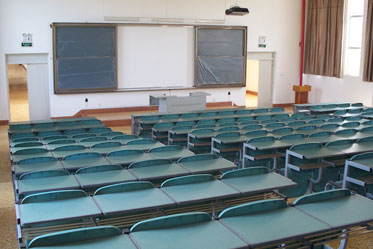
I had 125
students in this room on Monday mornings, and then they saw me again in
groups of 25 on Monday or Tuesday. It was a great way to teach (for I had
everyone "four hours" each week). |
|
Here are a few
photos of the old Kunming Medical University campus (in Kunming).
Most graduate
students study here after their first year, and some undergrad juniors and
seniors also study here. |
|

My post-graduate student classes all met in lecture halls
in
the South Classroom Building. |

This was the
library, just inside the front gate. It is now closed because they have
moved all the resources to Cheng Gong. |
|
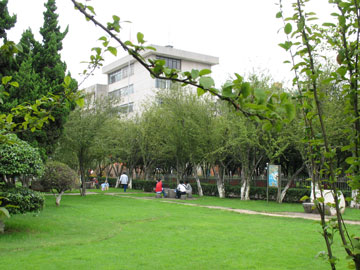
The center of
campus features a large park, with stools and tables under the trees for
students and retired staff (many live on the campus) to congregate around. You can also often find a group crowded
around a Chinese chess game. |
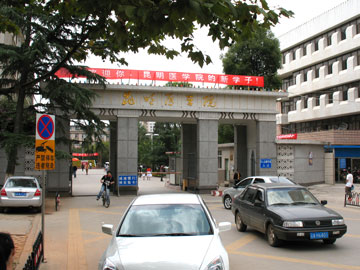
Here is the main
gate. It took about 20 minutes for me to walk home, and about 15 minutes to ride a
bus (longer if I had to wait 15 minutes for the right one!). So, unless it
was raining or I was carrying heavy things, I normally just walked. |
|
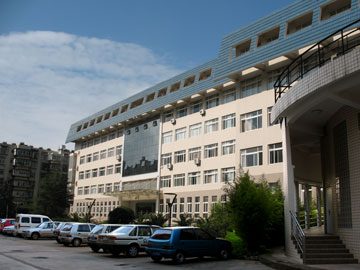
The Foreign
Languages Department was on the fifth floor of this building. I shared an
office up there with Chinese colleagues (on the new campus, the three
foreign teachers had a shared office). In the spring, I had undergraduate
classes in this building too (now they are in Cheng Gong). |
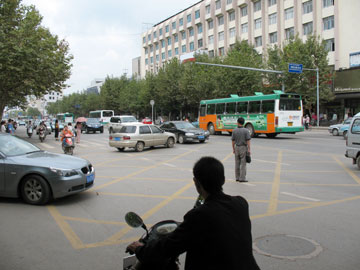
This is busy
Renmin Road, just outside the front gate. Notice that bikes, people and
cars are going in about eight directions at once. The most surprising
thing about this photo is that such things no longer surprise me like they
did when we first moved to China! |
|
More Photos:
Click here for photos of my current students
(or here for class materials). Click here for photos
of former students in Xi'an, Kunming, or
Shanghai.
Student
Essays: Click here
and here
to see student essays from my KMU students, or here for the
work of former students about NPU, Chinese holidays, and
more.
|













